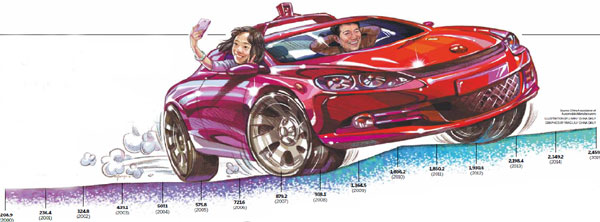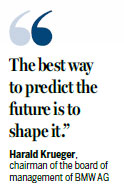Coming to roads near you: sofas that think
When Zhejiang Geely Holding Group started making cars about 15 years ago, its head, Li Shufu, saw cars as little more than a couple of sofas with four wheels attached.
Taking on board that reductionist view, what can we expect this mobile furniture to look like in, say, 15 years from now? Well, these sofas are still likely to be in place, but in two significant ways this motor vehicle will be a generation removed from the cars of today. They will run on electricity, and those seats will have become sofas in a very real sense, something to lounge back on, because the car will be driving itself.
In China that technological leap is all the more remarkable in that it will have come so soon after the motoring revolution of the past 35 years or so in which the number of private cars on the road has grown from just 20,000 to about 125 million now.
And the innovators are not hanging around. In fact, Lex Kerssemakers, chief executive of North American operations of Volvo, which Li's Geely bought in 2010, says he expects to see self-driving vehicles on the roads of Beijing or New York in little more than four years from now.
Boston Consulting Group predicts that by 2025 vehicles with some autonomous features such as highway autopilot or autonomous valet parking will account for 12 to 13 percent of car sales globally, and by 2035 sales of fully autonomous vehicles will account for nearly 10 percent of the market.
Just a few weeks ago an autonomous car owned by Changan Automobile of China completed a 2,000 km trip from Chongqing to Beijing, part of the company's efforts to produce highly automated vehicles.
In California at least 13 companies have been given permission to test autonomous vehicles. Mark Fields, the chief executive of Ford, said in April that the company is in the process of tripling the size of its test fleet to 30 fully autonomous hybrid sedans. Ford has been in the field for more than a decade, he said, and has proven its autonomous vehicles can work "flawlessly" in the dark.
"We are very serious about autonomous driving. Our priority is for our autonomous vehicles (to be) accessible to everyone and not only those who buy luxury vehicles."
Some semi-autonomous functions are already seen in production cars. Mercedes-Benz's all-new E-Class features Drive Pilot, which enables the car automatically to keep a proper distance to vehicles in front, to follow at speeds of up to 210 km/h, and help the driver brake or even change lanes automatically.
Xavier Mosquet, a senior partner in the Boston Consulting Group's automotive division, says autonomous cars that drive at low speeds are likely to be on the road by 2021 or 2022.
"You already have Google cars that are reasonably autonomous in San Francisco, and there are also experiments in Tokyo and Singapore."
New-energy vehicles, including pure electric ones and plug-in hybrids, are already part of people's daily lives in many countries, and experts believe they will eventually overtake or even replace petrol-driven ones.
The US company Tesla delivered 14,820 cars in the first quarter worldwide, up about 50 percent year-on-year, and aims to deliver 80,000 to 90,000 cars this year.
New-energy vehicles are thriving in China. Nearly 91,000 new-energy vehicles were sold in the first four months of this year, 131 percent more than in the corresponding period last year, the China Association of Automobile Manufacturers says.
At the recent Beijing motor show, new-energy models accounted for more than 10 percent of all cars displayed.
Traffic authorities in Beijing say that nearly half the city's license plate quota for electric cars for this year were used up by the end of April, indicating local residents' growing acceptance of new-energy vehicles.
Public data show that major Chinese car makers have made new-energy vehicles one of their strategic objectives in the next five years, and international ones are bracing themselves to get a decent share of the market.
Matthias Muller, CEO of Volkswagen Group, says: "China will be the fastest-growing market for new-energy vehicles worldwide.
"So for us, it's crystal clear: The future of e-mobility is strongly connected to this market. In China the future is now."
Volkswagen is helping regional markets to be more responsive to customer demand and tastes, particularly those in China, where 15 new locally produced new-energy vehicles will be rolled out by 2020.
Another thing that car makers agree on is the necessity of onboard connectivity, which they say will alter the automotive industry.
"If the automotive industry does not want to run the risk of having its status downgraded to that of a hardware supplier, we have to make sure we take advantage of the big technological trends ourselves," Muller says.
William Li, founder of NextEv, a Chinese startup aspiring to make electric and smart supercars, says connectivity is something carmakers have to provide to meet the demands of a customer base that grew up in the age of the internet.
Harald Krueger, chairman of the board of management of BMW AG, says: "Our technologies will learn to learn from people. And connectivity is becoming second nature.
"In China the share of post-90s in the Chinese car market was 15 percent last year and this will increase to 45 percent in 2025. In other words the next generation of customers were born into the digital age. Technology is becoming human.
"The best way to predict the future is to shape it."


(China Daily 05/30/2016 page13)














